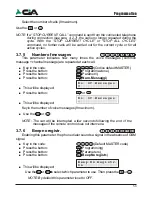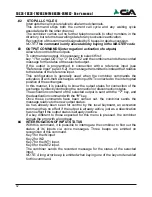
61
Operation
60
TDC26-TDC36-TM26GSM-TM66GSM-ERMES2- User’s manual
4.2.8 REMOTE
CONTROL
or
The combiner is able to interpret the DTMF multi-frequency tones commonly
generated by telephone apparatus, and therefore to carry out commands or send
information during a telephone connection.
If the
“Remote Control”
option is programmed to ON (see para 3.7.1) and
“Response Pulses”
is greater than zero (see para 3.7.3), it is possible to access
remote control either by telephoning the combiner directly or during an alarm call.
To activate remote control, it is necessary to key in a valid access code (see para
3.8) within approximately 10 seconds from connection if the call comes from the
remote user, or within 10 seconds from the end of the last voice message when the
call comes from the combiner.
If the combiner accepts the code keyed in, it transmits three beeps in slow
succession (approximately 1 per second).
When remote control is activated, "REMOTE MANAGEMENT” appears on the
second line of the combiner display. During remote control, if the combiner does not
receive a DTMF multi-frequency tone for more than 3 minutes, it interrupts the
connection and cancels remote control
!
Key in the code from the telephone
(Default MASTER code) or
(Default MASTER code) (see
para . 3.8)
The following is displayed on the combiner:
Key in from the telephone:
#0
STOP CURRENT CALL
Interrupts the call in progress and cancels the call for the whole cycle.
With this command, the combiner carries out no further calls to the current
number during successive call cycles relative to the activation of the channel.
The combiner signals recognition of this command with 5 beeps in rapid
succession (approximately 2 per second).
This command does not end communication: it is necessary to key in the
command “# # #” to break it, or else wait for the end of the call.
#1
STOP CURRENT CYCLE
Interrupts the call cycle relative to the single alarmed channel.
This command cancels the current call cycle and communicates to the
combiner not to contact the remaining numbers in the directory.
Recognition of this command is signalled by 5 beeps in rapid succession
NOTE:
This command is only executable by keying in the MASTER code.
C o n n e c t e d
. . . . . .
R E M O T E
M A N A G E M .
_
4.2.6 IN
SERVICE
This command returns the combiner to normal operation from an “Out of Order”
condition.
!
Key in the code:
(Default MASTER code)
!
Press the button:
(
In Service
)
!
Viene visualizzato for some second:
NOTE:
This command is only executable by keying in the MASTER code
4.2.7 TELEPHONE
This allows for making a speakerphone call from the combiner in order to test the
correct operation of the telephone line.
!
Key in the code:
(Default MASTER code)
!
Press the button:
(
Telephone
)
This will be displayed
Select the telephone number.
!
Press the button
or
!
This will be displayed:
It is possible to hear the multi-frequency tones or pulses generated by the
combiner through the loudspeaker, as well as the signals from the telephone
network. The combiner waits for a response up until the tenth ring, then aborts the
attempt.In the case of a response, the combiner commits the line for as long as the
connection remains active, or for as long as no key is pressed.
NOTE:
This command is only executable by keying in the MASTER code.
I N
S E R V I C E
_
E n t e r
n u m b e r
_
_
2 3 ¥ C a l l . . . .
0 1 2 3 4 5 6 7 8 9
Number of telephone selectioned




































